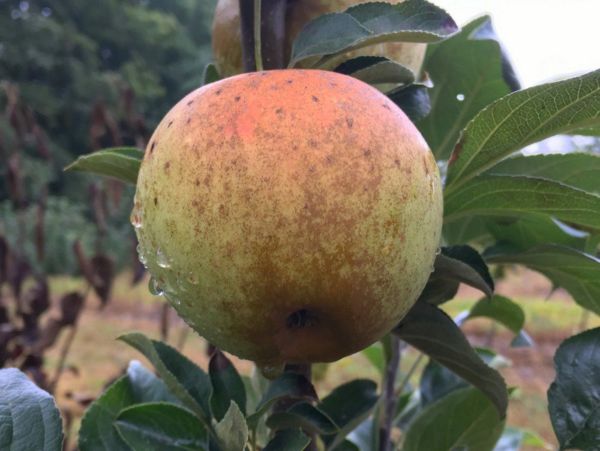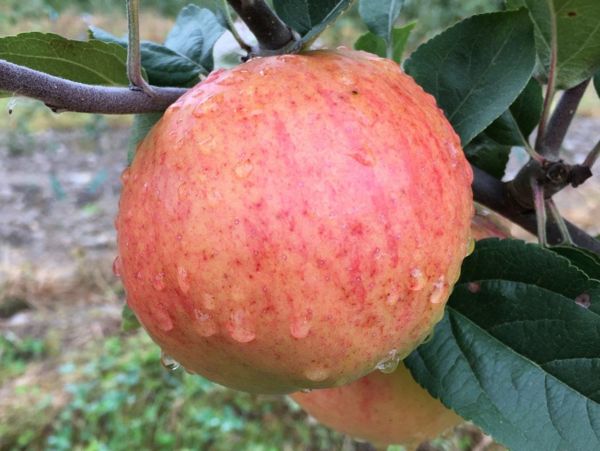An attractive, highly disease-resistant apple, ideal for organic growers.
Brown Snout Apple Scionwood (Spring 2024)
A traditional English bittersweet cider apple.
This is a medium-sized tree that has a distinctly upright habit; care should be taken to avoid splitting under heavy crop loads. It is highly susceptible to fireblight and somewhat susceptible to scab. Brown Snout is a productive variety, but like many cider apples it tends to biennialism and needs to be thinned to maintain regular production. It is very late blooming, and a pollination partner should be chosen carefully. Brown Snout is an apple that is used predominanly for cider; it is not typically esteemed for fresh eating.
Brown Snout produces a late-season bittersweet cider apple. It is a smallish fruit with a greenish yellow base that is heavily russeted around a shallow calyx, whence its name. The juice is a mellow, dark cider with high tannins. Eve's Cidery writes of Brown Snout: "It is one of the best. Bittersweet with soft, warming tannins that are never bitter." This apple does not store well and should be pressed soon after harvest. From WSU: Tannin (percent tannic acid): 0.16; Acid (percent malic acid): 0.31; pH: 3.64; SG: 1.051; oBrix 12.9.
Thought to have been discovered on a farm in Yorkhill, Herefordshire, Brown Snout was eventually propagated by the H. P. Bulmer Company and planted across the west Midlands.
Volume Pricing
| Quantity | Brown Snout Apple Scion |
|---|---|
| 1 | $12.00 |
| 2-5 | $7.00 |
| 6-10 | $6.00 |
| 11-99 | $5.00 |
| 100+ | $4.00 |
The Fruit
Fruit Type
Category: Apple
Subcategory:
Heirloom, Cider, Cold-Hardy, Hot-Climate
Fruit Uses & Storage
Uses: cider
Cider classification: bittersweet
Storage duration: less than one month (approximate, depending on storage conditions)
Fruit Appearance
Skin color: green
Flesh color: white
Fruit Origins
Parentage: unknown
Origin: Herefordshire, England
Introduced in: 1850s
Introduced by: H. P. Bulmer Company
The Environment
Calendar & Geography
USDA zones: 4 - 8
Chill hours: Not yet determined
Ripening date: Oct 13 (approximate, in New York State) + 28 days after McIntosh
Diseases & Pests
glossary
Apple Scab: Susceptible
Fireblight: Very Susceptible
Pollination
Pollination Factors
glossary
Bloom group: 5
Is it self-fertile? N
Is it fertile? Y
Ploidy: Diploid
Pollination Partners
This table shows the first few results from a full search for pollenizers of Brown Snout Apple. Please see our Pollenizer Search to run other queries and read how the application uses various factors. Also read more about fruit tree pollination.
| Tree | Currently in Stock |
|---|---|
| Florina Apple | 0 |
| Porter's Perfection Apple | 0 |
| Spitzenburg Esopus Apple | 0 |
| Rubinette Apple | 0 |
| Virginia Crab Apple | 0 |
| Binet Rouge Apple | 0 |
| Mother Apple | 0 |
| Melrose Apple | 0 |
| Fenouillet Gris Apple | 0 |
| Sturmer Pippin Apple | 0 |
| Kingston Black Apple | 0 |
See all pollination matches for Brown Snout Apple
Featured Products
A few things we're loving right now...
A full-flavored, freestone white peach.
A traditional semisharp cider apple from Spain.
A widely-grown, large, yellow-fleshed nectarine.










-001.jpg)

-001.jpg)



